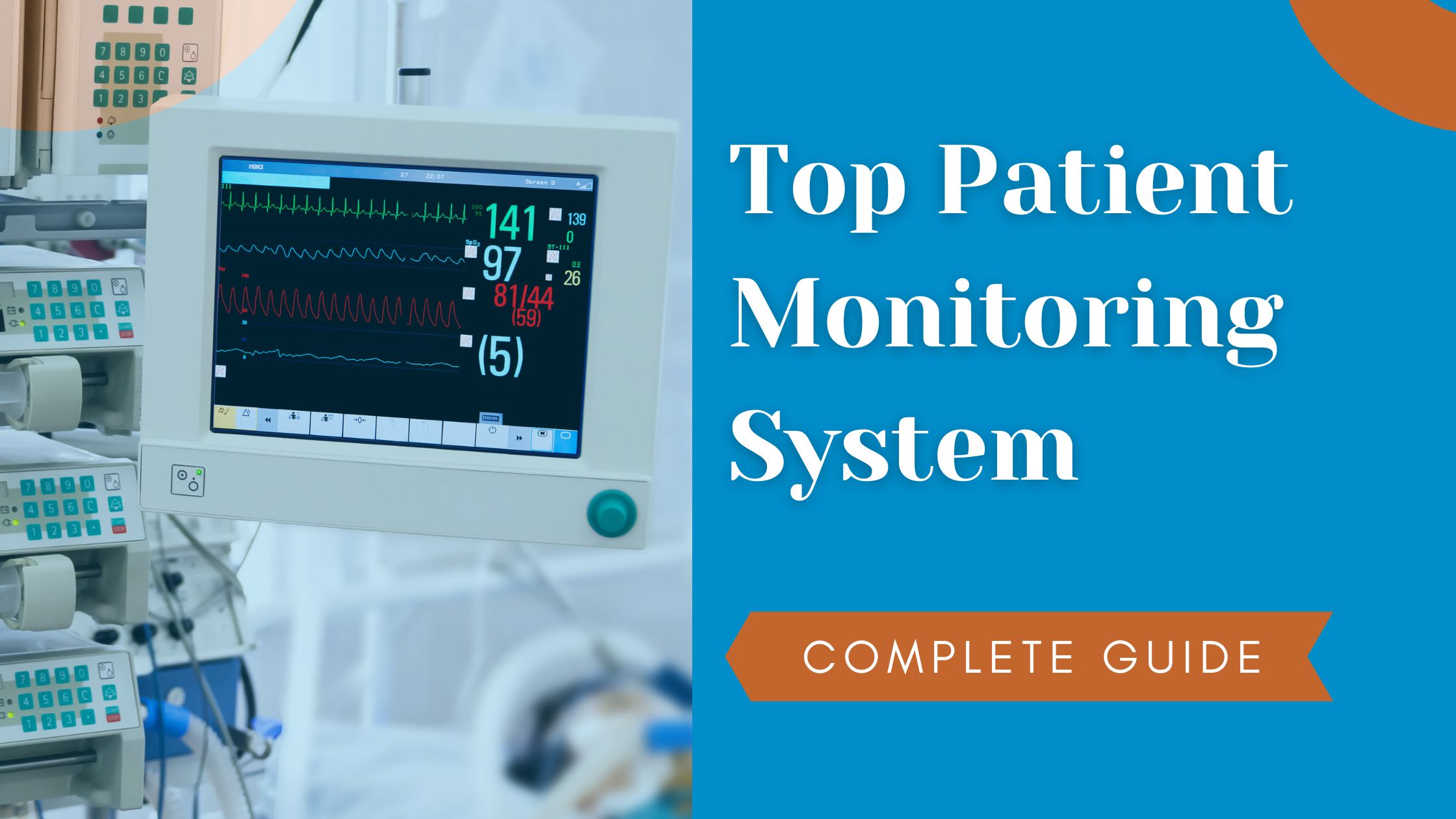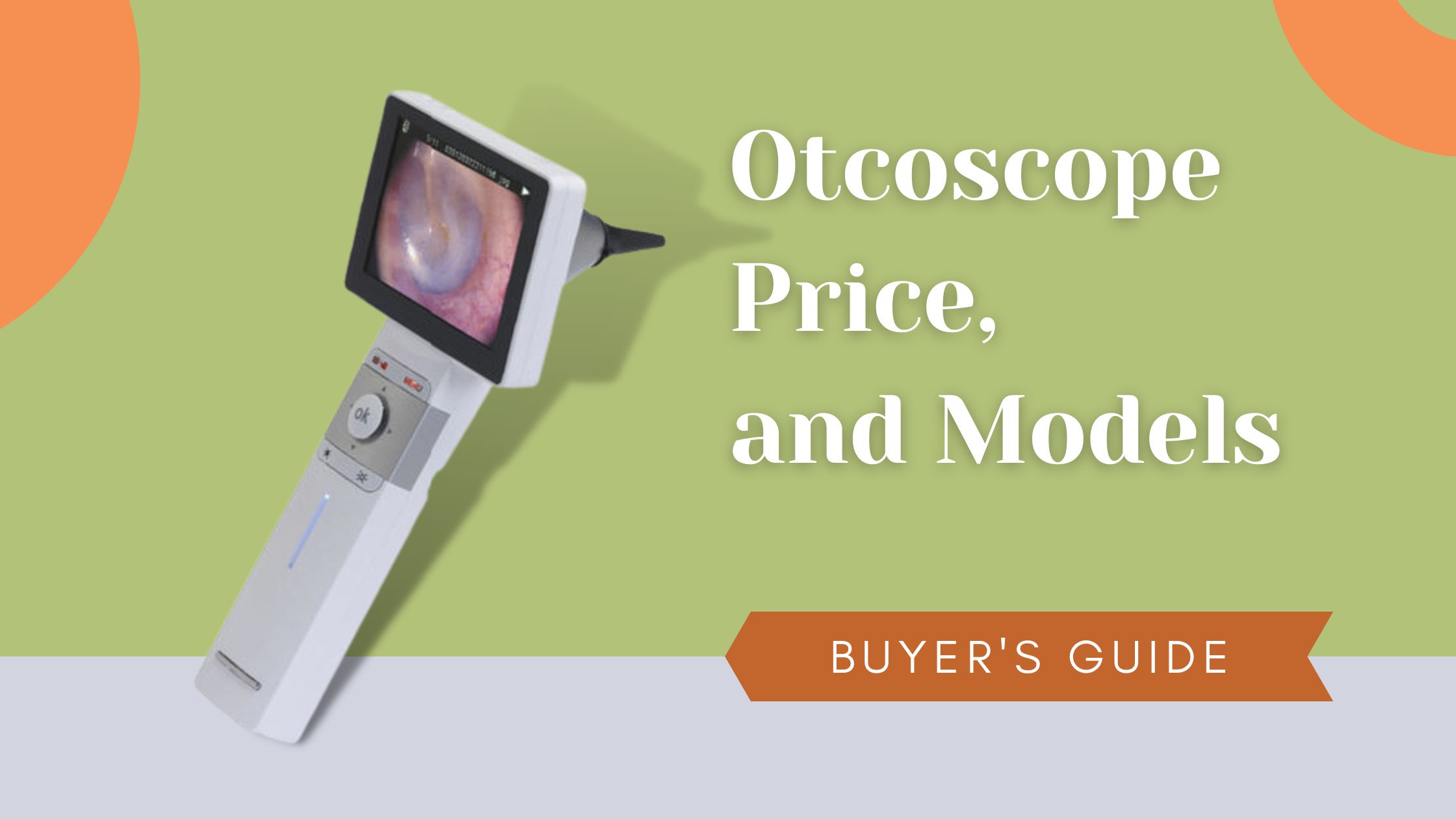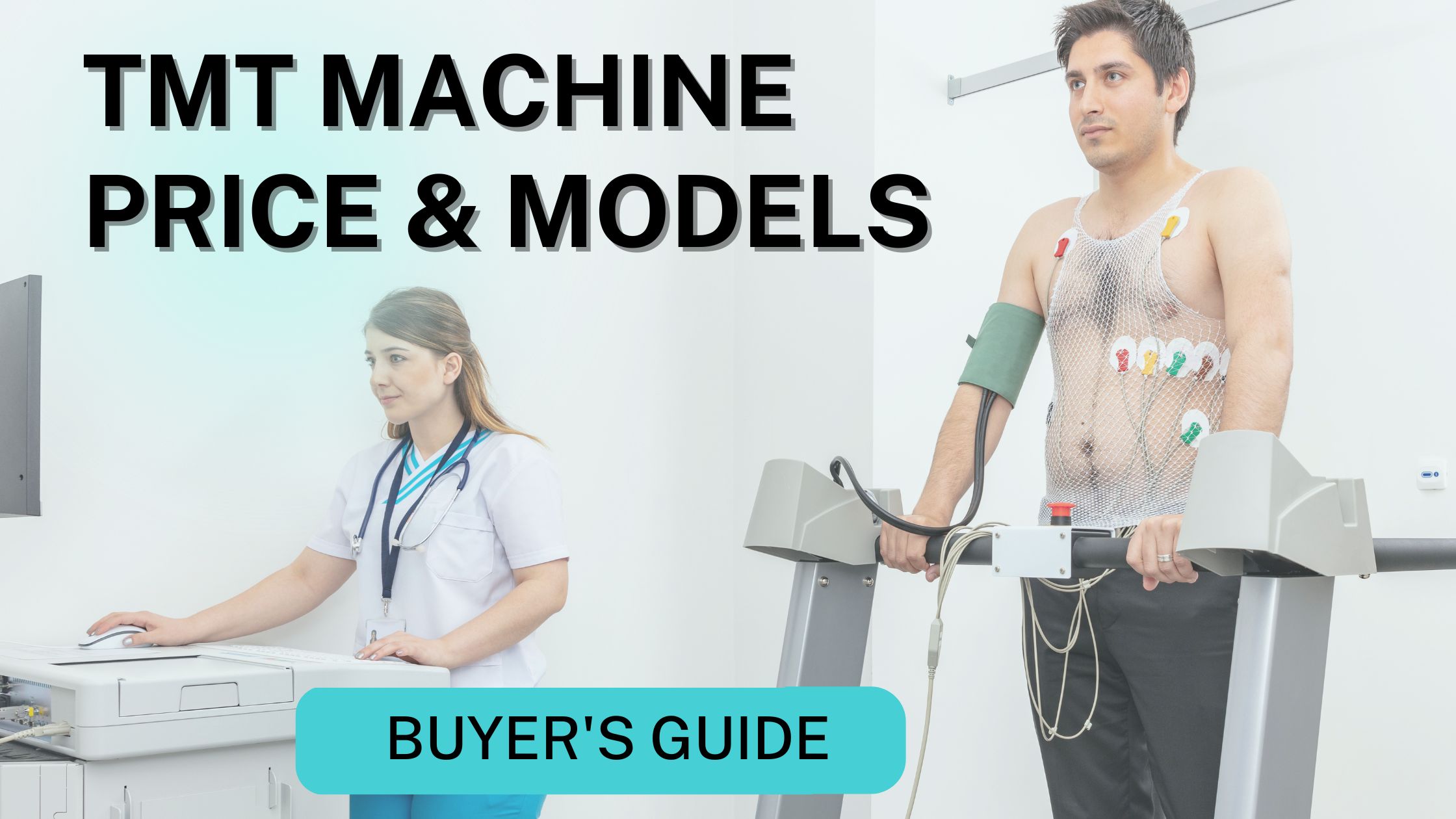Oxygen Concentrator
If someone has some health issues and it is related to causes your oxygen level drops instantly too low. An oxygen concentrator is a device that provides you with extra oxygen your doctor recommended if you are suffering from lower oxygen levels.
This device helps people is someone suffering from trouble breathing due to these conditions;
- Covid-19 patient
- Asthma patient
- Lungs cancer patient
- Someone suffering from FLU
Make sure you use the oxygen concentrator device according to the doctor’s prescription and guidance. Your doctor guides you on how much oxygen you should take and how long you should use this device.
Without doctor guidance or any prescription, using the device can be dangerous for you. Once you think you can start to use or need the oxygen concentrator to consult about this with your doctor.
- Types of Oxygen Concentrator Machine
- Pulse Dose & Continuous flow oxygen concentrator
- Benefits of oxygen concentrator differences portable & home units
- 7 Best oxygen concentrator models in India 2021
- Pros and Cons of Philips oxygen concentrator everflo-
- Demo video of Philips oxygen concentrator overflow
- Pros and Cons of BPL oxygen concentrator 5, Oxy Neo single flow
- video demo of BPL oxygen concentrator 5, Oxy Neo single flow
- Pros and Cons of Devilbiss oxygen concentrator compact model 525, 5L
- Video demo of Devilbiss oxygen concentrator compact model 525, 5L
- Pros and cons of Oxymed mini oxygen concentrator
- Demo video of Oxymed mini oxygen concentrator
- Pros and Cons of SimplyGo Portable Oxygen Concentrator
- Video Demo of SimplyGo Portable oxygen concentrator
- Pros and Cons of Devilbiss 10 Liter Oxygen Concentrator, For Clinical Purpose
- Video demo of Devilbiss 10 Liter Oxygen Concentrator, For Clinical Purpose
- Pros and Cons of SimplyGo MiniPortable oxygen concentrator (POC)
- Video of SimplyGo Mini Portable oxygen concentrator (POC)
- Things to consider before buying oxygen concentrator
- Conclusion
- FAQs: Oxygen Concentrator
Types of Oxygen Concentrator Machine
There are two types of oxygen concentrator machines available on the market pulse dose & Continuous flow oxygen concentrator and intermittent flow oxygen concentrator these devices have different benefits and constraints and are best suited for specific patients.
Pulse Dose & Continuous flow oxygen concentrator
This portable oxygen device has two different types of setting the pulse dose and continuous flow concentrator.
The pulse dose concentrator mode is used usually during the daytime it delivers air through the cannula when you inhale oxygen concentrator pulse dose technology is more close-packed in design and offers a longer battery life.
The Continuous flow of the oxygen concentrator mode delivers a constant airflow through the tubes. This type of component is for the people who need oxygen while they are sleeping. This mode is best for heavier home units.
Benefits of oxygen concentrator differences portable & home units
Both of these oxygen concentrators or portable and home units have several types of advantages for people who need oxygen therapy.
The oxygen concentrator is less dangerous in comparison to traditional oxygen cylinders. Which is a leakage problem or increases the chances of firing. That old-fashioned liquid oxygen cylinders have caused the kindling.
On the other hand, oxygen concentrators are not dangerous. Portable and home oxygen concentrators, manufactured their own oxygen without the further ongoing cost of refilling tanks of oxygen. Has become more popular than old-fashioned oxygen tanks.
7 Best oxygen concentrator models in India 2021
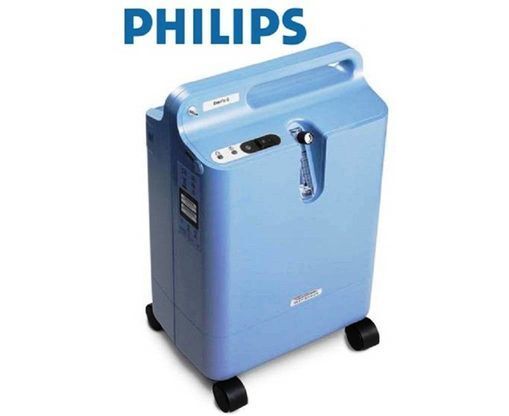
1) Philips oxygen concentrator everflo-
- Oxygen flow the oxygen concentrator everflo it is 5 LPM-5LPM it means you can adjust your oxygen requirement up to a maximum the 5LPM according to your doctors prescription.
- The oxygen flow meter is the adjustable flow meter you can adjust oxygen flow according to yours.
- Oxygen concentration the higher oxygen concentrator level furthermore 93 + / -3% at 5LPM. It means Philips oxygen concentrator gives minimum 90% and maximum 96% oxygen concentrator maximum oxygen flow is 5LPM.
- The low power consumption of this oxygen concentration power consumption is 350w. It is less than the coffee maker means. You can run it on the inverter after the power cut.
- The input voltage in AC 220 + / -10%
- Warranty 3 years
- This is lightweight the weight of an oxygen concentrator overflow is 14kg which makes this portability easy
- Indicator of oxygen machine oxygen 82% and very low oxygen 70%
- Country of origin is the USA
Philips oxygen concentrator everflo – Philips oxygen concentrator is the number 1 brand in the lists of Philips oxygen concentrator everflo is the most trusted brand in the top oxygen concentrator manufacturing. Philips Respironics oxygen concentrator has had the largest network of dealers and permit service centres in the Indian market for a long-time.
Why? The Philips concentrator is in the no 1 on the list the answer is simple! Its quality and features are wonderful. It is lightweight, has low power consumption, lower maintenance, a 3 years warranty and long life. These wonderful features make this Respironics oxygen concentrator special.
Pros and Cons of Philips oxygen concentrator everflo-
Pros
- Lightweight for easy transport
- Low maintenance for reducing services cost
- Compact design looks less like a medical equipment
- Lower power consumption
- Recessed flow meter reduced accidental breakage
- oxygen purity indicator option for increased security
Cons
- The weight of the oxygen concentrator is still 10 pounds difficult for some patients to easily carry.
- The size of this concentrator is not travelled friendly.
- This oxygen concentrator wants several types of different alarms needing alarm attention.
- It has lots of accessories it not only includes a battery but also carrying a case, shoulder straps, outlet charger etc.
Demo video of Philips oxygen concentrator overflow
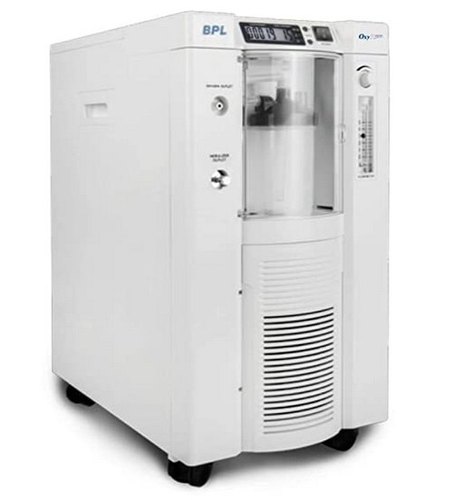
2) BPL oxygen concentrator 5, Oxy Neo single flow
- Oxygen flow is 0.5 to 5 LPM with an adjustable flow meter.
- Timer set function you can set the oxy timer 0 to 90 minutes after that your BPL oxygen concentration shuts down automatically.
- An oxygen concentrator is 93%
- Alarm safety feature this oxygen machine comes with an LED light that starts blinking if your oxygen machine detects an error during the oxygen supply.
- The warranty is 1 year.
- Origin of country china
- The regular price of a Bpl machine in India is 40,000 to 50,000 INR (Note: due to pandemic covid-19 the demand for this machine is high that’s why ranges are increased by 60,000 to 70,000 INR.
- If your BPL machine faced some problem then don’t worry BPL is the only company that provides you with onsite services all you have to do is give it to a customer care executive with a machine guarantee card.
BPL brand is the most authentic and trustable brand of all medical equipment in India. They had the largest network of dealers and authorized authentic services in the Indian market for a long time. This oxygen concentrator machine comes with a flame retardant thermoplastic upper body that makes it strong. This BPL machine comes with 93% of oxygen purity; it has safety features, a high-pressure safety valve, a power failure alarm function and a fault self-detection system.
The two specific features of this machine are it comes with LCD screen and the second best feature is it has a timer set function
0 to 90 minutes, if your patient needs only less than 90-minute oxygen you can set the 60 minutes timer of the BPL oxygen concentrator. The BPL Oxy 5 neo oxygen concentrator shut down automatically.
Pros and Cons of BPL oxygen concentrator 5, Oxy Neo single flow
Pros
- The double outlet of 5-litre
- Built-in the nebulizer
- The timer function is an automated shout down
- user-friendly reliable and quiet
- LCD screen to view the usage hours
Cons
- Size is not travelled friendly.
- produce more heat by the time.
- Long hours using after need 20 – 30 minutes rest.
video demo of BPL oxygen concentrator 5, Oxy Neo single flow
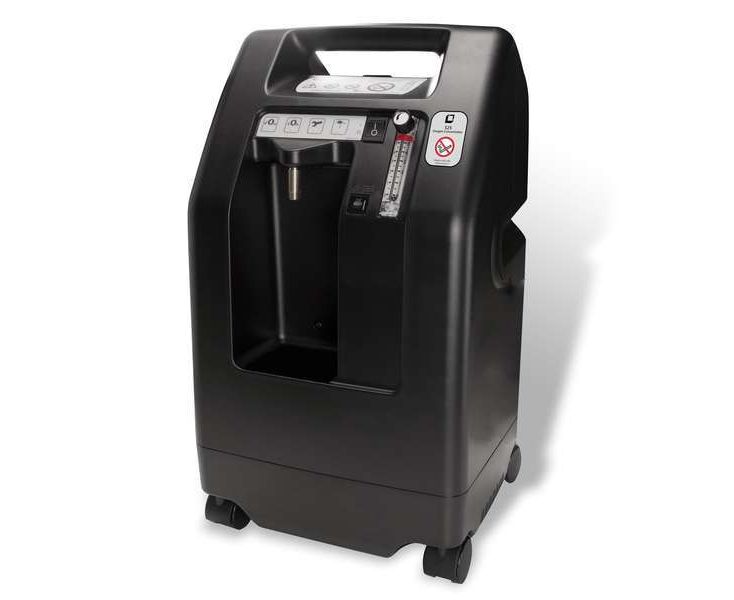
3) Devilbiss oxygen concentrator compact model 525, 5L
- The best feature of this oxygen concentrator machine is this device does not need any requirements of maintenance for 2 years.
- The flow meter of this oxygen concentration is 15% quiet with sound quality improvement.
- Simple to assemble and disassemble.
- Oxygen flow: 5 LPM to 5LPM
- Oxygen Concentrator: 93 + / – 3%
- The low power consumption of this machine is 290W at 2 LPM and 312W at 5 LPM
- Voltage input is AC 220 +/- 10 V
- The weight is 16.3kg
- Warranty 3 years
- Origin USA
- Price between 50,000 to 70,000 2021 in India.
In our list, next to the oxygen concentrator is a Devilbiss oxygen concentrator. This oxygen concentrator is a global leader in design manufacturers. Marketing of respiratory medical equipment like oxygen machines, CPAP, BIPAP etc.
Same like Philips oxygen concentrator its features are smooth lightweight, low power consumption, low maintenance, three years warranty life long etc. This oxygen machine has the most powerful compressor and this concentrator is also imported from the USA.
Pros and Cons of Devilbiss oxygen concentrator compact model 525, 5L
Pros
- 15% typical sound quality improvement – Noticabely quiet operation.
- Easy to Assemble and Disassemble.
- convenient top and side handle for effortless transportation.
- Patient controls and protected cannula fittings.
Cons
- Does not come with an oxygen purity analyzer.
- A little bulky as compared to another oxygen concentrator.
- It is a bit inconvenient to use as a rotatable knob to set the flow rate.
Video demo of Devilbiss oxygen concentrator compact model 525, 5L
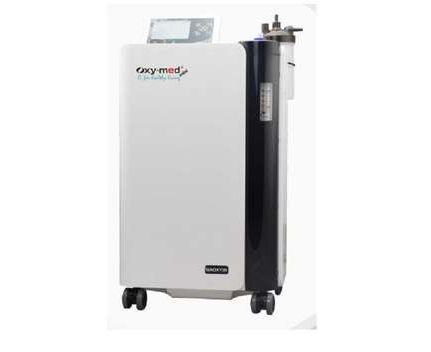
4) Oxymed mini oxygen concentrator
- Oxygen flow: oxymed oxygen comes with .5 – 5LPM oxygen flow
- The oxygen flow meter of the oxygen oxymed concentrator comes with an advanced digital oxygen flow meter.
- A higher oxygen concentrator is 93 +/- 3% at 5 LPM. It means this oxymed oxygen concentration gives a minimum of 90% and maximum 96% oxygen concentration and the maximum oxygen flow is 5LPM.
- The power consumption of an oxymed mini 5 LPM is 390W. It uses 1 unit of electricity every 2 hours and 33 minutes.
- Lightweight the weight of this machine is 13.90 Kg it means its portability is easy for this machine.
- Input power is AC 220 V
- Low purity low-pressure alarm
- Warranty 3 years
- Origin of the country is china
- The price of an oxymed oxygen concentrator is 30,000 to 40,000 in India.
Are you Looking for a budget-friendly oxygen concentrator then the mini oxymed mini oxygen concentrator is best for you. This manufacturing unit is based in China but the sieve beds are imported from France and the compressor from Germany.
One of the special features of this machine is it comes with a foldable 3.5-inch display which assures you the patient is getting pure oxygen.
Pros and cons of Oxymed mini oxygen concentrator
Pros
- This is a lightweight 13.90 kg which makes this portability easy this machine
- This oxygen concentrator comes with an advanced digital oxygen flow meter.
- The low-pressure alarm
- price range is affordable
- Comes with a foldable 3.5-inch display
Cons
- The power consumption is very low 2 hours 33 minutes.
- The display is not big.
Demo video of Oxymed mini oxygen concentrator
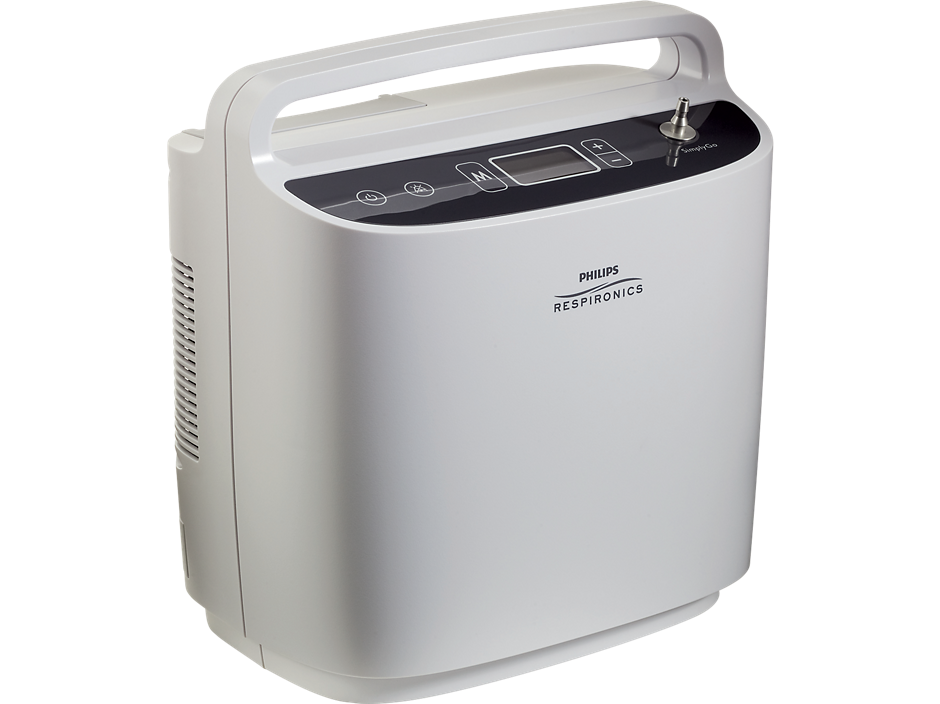
5) SimplyGo Portable oxygen concentrator
- Weight with battery – 4.5 (10) kb (lbs)
- DC power output – 19 VDC and 7.9 A max
- AC power input – 100 to 240 VAC/ 50 to 60 Hz/1.7 A max
- Size – 29.2 cm x 25.4 cm x 15.2 cm (11.5″ x 10″ x 6″)
- SimplyGo’s battery duration – 3.0 (pulse dose setting of 2*) and 0.9 (continuous flow 2 LPM) hour(s)
- Pulse mode bolus size – 1=12 ml/1.5=18 ml/2=24 ml/2.5=30 ml/3=36 ml/3.5=42 ml/4=48 ml/4.5=54 ml/5=60 ml/5.5=66 ml/6=72 ml
- Sound level – less than equal to 43 dB at pulse setting 2 dB
- Power consumption – 150 while charging/120 while not charging W
- Operating temperature – 5° to 40°C (41° to 104°F)
- Lithium Ion battery – 14.4 VDC 6600 mAh (LiIon), 0.7 kg (1.5 lbs), charge time is approximately 2 to 3 hours per battery from fully discharged
- Alarm types – Low oxygen purity/No breath/High breath rate/No flow/Low battery/Depleted battery/Wrong battery/System technical fault
- DC power input – 11.5 to 16 VDC and 18 A max
- Continuous flow settings – 0.5/1/1.5/2 l/min
- AC power output – 19 VDC and 7.9 A max
- Filtration – Internal bacteria filter
- Oxygen Concentrations – 86 to 97% at all settings %
- Storage temperature (unit only) – -20° to 60°C (-4° to 140°F)
- Altitude – Up to 3.048 m/10,000 ft
SimplyGo Portable oxygen concentrator offers continuous flow and Pulse-dose delivery in a device the weight of this device is 10 pounds. This device helps reliably manage the therapy and lifestyle needs of your patients with just one POC. Simply patient management with SimplyGo.
Pros and Cons of SimplyGo Portable Oxygen Concentrator
Pros
- This device have multiple types of alarms.
- SimplyGo comes with a plethora of accessories, users will end up saving a lot of money on accessories.
- This SimplyGo is a dual-mode oxygen concentrator offering both pulse mode and continuous flow oxygen delivery.
- Its compactness makes for easy storage both at home and while travelling.
Cons
- The simplygo weight is still 10 pounds this might make it difficult for some patients to easily carry.
- Users should not expect the fully charged battery to last more than 3 hours.
- This device is At, 43 decibels about the same volume as a refrigerator humming, it may not be the best choice for quiet environments.
Video Demo of SimplyGo Portable oxygen concentrator
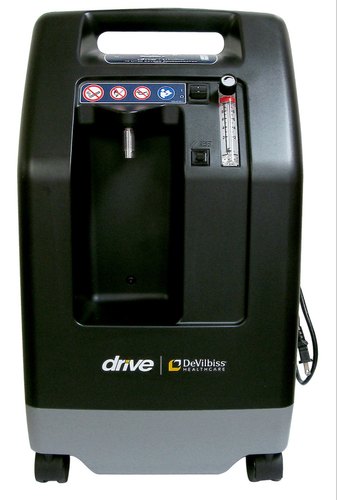
6) Devilbiss 10 Liter Oxygen Concentrator, For Clinical Purpose
- model name/number – 1025DS
- Capacity(Litre per minute) – 10 LPM
- Dimensions – 62.2×34.23×0.4 I’m
- Sound level – Less than 40
- weight (kg) – 19kg
- Oxygen concentration – 87% to 96%
- Power consumption – 230v
- Outlet Pressure – 20.0 +/- 1.0 psi
- Features – high-pressure 20psi
- Alarms – high pressure/ low flow/ power failure/ oxygen high gas temperature
- It is portable – None portable
- Oxygen Flow – 2-10lpm
- Alarm – Audible and visual high pressure, low/high flow, low oxygen, high gas temperature, power failure, Ox
- Display Type – LED
- Flow Settings – 20.00 PSI +/- 1.0 PSI
This device is lightweight and compact, clear design for easy use the digital hour meter- easy to read the top of the device convenient top side handles for easy transportation front level with clearly visible LED. Capable of delivering up to 96% purity from 2LPM to 10LPM. OSD sensor for continuously monitoring oxygen levels. Oxygen outlet incorporating a fire protection adapter
tested in high temperature and high humidity for extended periods. Alarms do not require a battery and indicate power failure, high gas temperature, high pressure, low and high flow, low oxygen and service required.
Pros and Cons of Devilbiss 10 Liter Oxygen Concentrator, For Clinical Purpose
Pros
- The electricity is cost-effective usage.
- A kit that speaks of reliability and no compromise on quality, it can supply up to 5 litres per minute at high concentration oxygen.
- Designed with the most powerful compressor, supplying oxygen up to an altitude of 13123 ft.
Cons
- It does not come with an oxygen purity analyzer.
- A little bulky as compare to other leading oxygen concentrators.
- It is a bit inconvenient to use a rotatable knob to set the flow rate
Video demo of Devilbiss 10 Liter Oxygen Concentrator, For Clinical Purpose
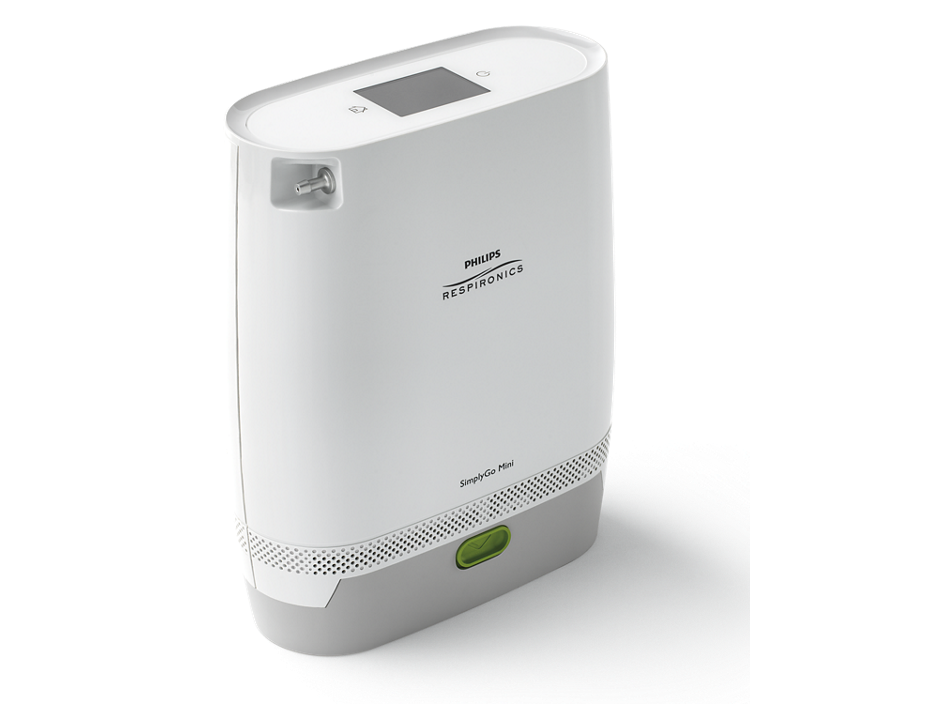
7) SimplyGo Mini
Portable oxygen concentrator (POC)
- Lightweight and easy to carry at only 5 pounds
- Five pulse dose settings designed to keep you on the go
- Easy-to-use and read lcd touch screen
- Simple-to-replace/remove rechargeable battery: Standard battery for battery duration up to 4.5 hours extended battery for battery duration up to 9 hours
- FAA certified for travel
- Can be used 24/7 at home or away
- The SimplyGo Mini has 2-year standard warranty. NOTE: 2 years standard warranty is for the device only – battery, accessories and consumables have a warranty of 90 days
The Philips SimplyGo Mini Portable Oxygen Concentrator is sleek and lightweight. It is a tiny powerhouse that’s easy to use, and simplifies your life by making its own oxygen from the air around you! And because it’s a tank system with no big, awkward tanks to hassle with, no oxygen deliveries to schedule. The Philips SimplyGo Mini is virtually worry-free. Simply go mini can also used on during travel in flights.
Pros and Cons of SimplyGo Mini
Portable oxygen concentrator (POC)
Pros
- Model is small and light weight.
- This is travel-friendly easy to carry.
- Easily stored in a pocket or purse.
Cons
- Battery life is short.
- you can not use your own inhaler with this product.
- you may experience sore throats and difficulty swallowing.
Video of SimplyGo Mini Portable oxygen concentrator (POC)
Things to consider before buying oxygen concentrator
one of the most important factors before buying oxygen concentrator machine is check the flow rate capabilities flow rate indicates the rate of which oxygen is able to travel from the machine to the patient.
Check the flow rate
An ideal process is before buying the oxygen concentrator to advise the ideal flow rate it is recommended that you have to discuss any potential oxygen concentrator purchases with your doctor first.
The Power consumption
The power consumption of your device should be in the range of. It is advisable to purchase the concentrator that boosts the lowest power consumption and your oxygen requirements as per your doctor prescription.
Conclusion
It is good to consider and prescribed by the doctor before buying and spending on any type of oxygen concentrator the quality should be your first concern your machine quality as an on the top and most important thing is before buying any oxygen concentrator check the reviews and features of your product.
FAQs: Oxygen Concentrator
- What is the price of oxygen concentrator?
The minimum price of oxygen concentration in India is 30,000 to 70,000 apart from that it utterly depends on which type of model you want the prices according to the models and product quality.
2. How can I decide on the best oxygen concentrator? Before buying it.
Before buying the oxygen concentrator some things you should keep in your mind are flow rate, noise, portability, oxygen concentrator.
3. How many hours we should use the oxygen concentrator?
Generally, the life of an oxygen concentrator hours of life 1,500 to 2,000.
4. What is the maximum concentration of oxygen that can be achieved with the concentrator?
up to 94%
5. How many babies can be treated at a time with the oxygen concentrator?
up to 4 babies using a spillter.
6. What is the running cost of equipment?
The initial cost of the equipment is 45,000 to 50,000 which may be considered expensive in comparison to cylinders the yearly running cost of 12,000 to 15,000 is substantially, less than the Rs 2.5 to 3 lakh for providing cylinders and the Rs 1.2 to 1.3 lakh for liquid oxygen. Thus on cost alone, the oxygen concentrator is the preferred means of providing oxygen treatment in developing countries with limited resources.
7. What is the life of the Zeolite sieve filters?
The life of the zeolite crystals can be expected to be at least 20,000 hours which in
most situations would give about 10 years use.
8. What kind of maintenance is required for the oxygen concentrator?
The device is as simple to manage as it looks. All that is required is that the coarse
filter has to be washed each day and replace the other filters as per instructions of
the company, which is usually at 6 months or 1500 hours of use. The filters may
also need to be changed according to local conditions (dust, humidity) and the
amount of use of the concentrator. Skilled mechanical maintenance is needed only
yearly. There is a fourth filter, the bacterial filter, located before the oxygen outlet of
the concentrator. Typically this must be changed every year, or more frequently,
depending on the amount of use of the concentrator. The concentrator may work 24
hours a day, every day, as long as daily maintenance procedures are carried out.
Every concentrator has an hour meter. The working hours should be written down
in the service report.
9. What are the Precautions during usage of the oxygen concentrator?
The precautions to be observed are:
• The concentrator should be placed as far away from the window as possible to avoid dust and moisture.
•The concentrator should not be used to deliver oxygen through head box or face mask but use cannula.
• It should be kept far away from open flames.
•Oxygen cylinders are recommended as a backup oxygen supply system in case of power failure as the oxygen reservoir in the machine lasts for only 2-3 minutes.
•When a flow-splitter is being used, the total flow should not exceed more than 4 liters per minute or the concentration of oxygen will decrease. This happens because the canisters have a defined volume and can only separate a known volume of nitrogen at a given time. Therefore, concentrators must not be used at flows higher than those stated by the manufacturer.
10. What are the other methods of providing oxygen therapy?
The other methods of providing long term domiciliary oxygen are cylinders delivered
to the patient’s home (the most widely used method) and liquid oxygen in a domestic
tank replenished twice weekly in some countries. The capacity of the oxygen
cylinder can range from 40- 3445 liters capacity and cost between Rs. 2,625-
12,215. The cylinder can provide oxygen at 1 LPM for 11.3 hrs (e.g.680 litres
capacity cylinder) or 4 LPM for 2.8 hrs. Thus the overall running costs turn out to be
much higher than the oxygen concentrator. The use of a liquid oxygen system has
been investigated in the United States. The apparatus consists of a portable “walker”
and a reservoir which contains a supply for three to four days.
Regular deliveries are
required as for cylinders and this contributes appreciably to the cost.

